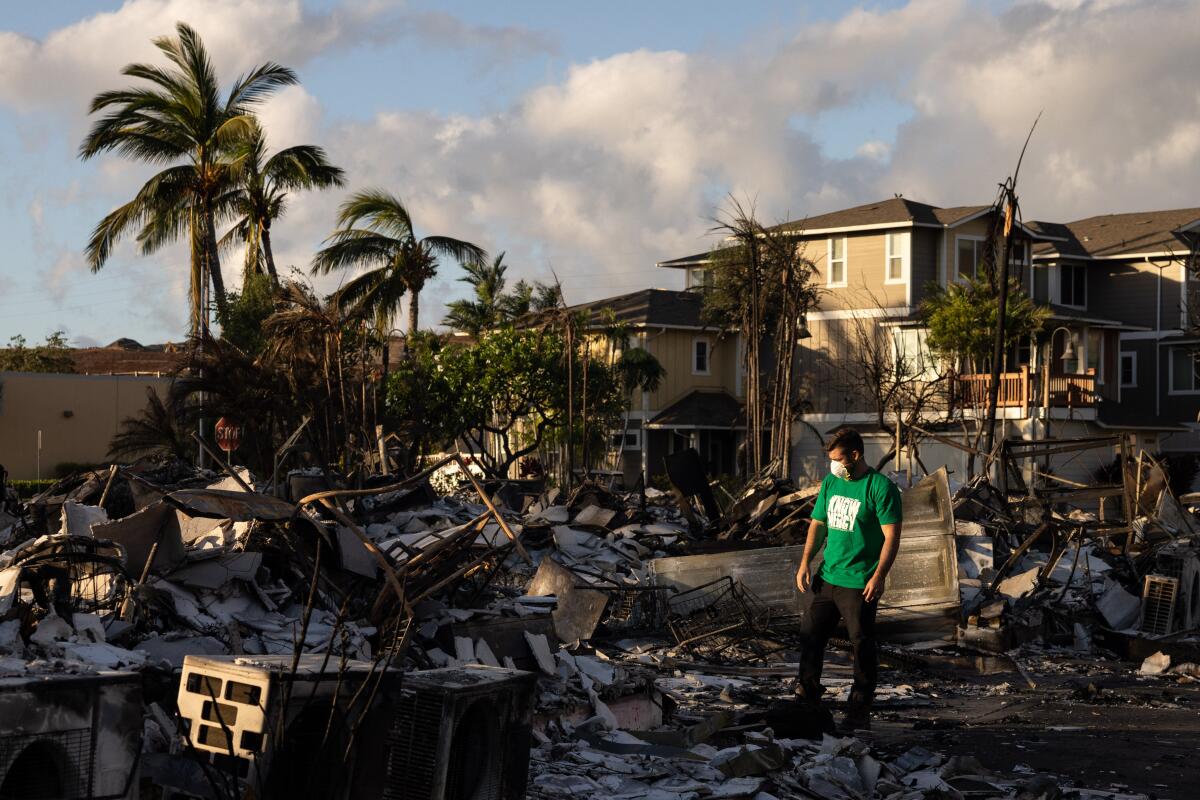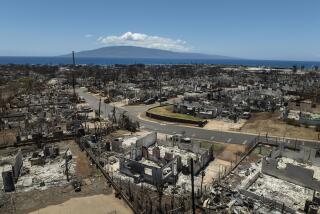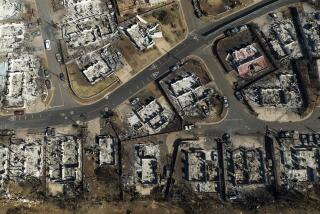Maui death toll surpasses Paradise; deadliest U.S. wildfire in a century

LAHAINA, Hawaii — Never before had Sefo Rosenthal seen anything like the wind driving down from the steep mountains behind Lahaina, in West Maui.
The gales pushed the flames with terrifying speeds toward Rosenthal’s family, friends and thousands of other unsuspecting residents and tourists.
Desperation forced many to jump into the ocean off Front Street, the heart of this historic town that has since been scorched and leveled.
“There was nothing else to do. You can’t go left, you can’t go right, you can’t turn around,” Rosenthal recalled. “The only thing left to do is go into the water.”
Rosenthal, 37, and his immediate family, who live a few miles north of the burn area, were spared. His grandfather’s house, built in 1972, burned to the ground. His aunt escaped as she “could barely see, driving through smoke.”
Not everyone was so lucky. A friend he knew since they “were little kids” died in her car with her son, Rosenthal said, adding after a long pause, “and her parents.”
The devastation in Maui has reached a breathtaking scale, with officials confirming Saturday that at least 93 people have died and about 1,000 more remain unaccounted for. The Maui fires are now the deadliest in the U.S. in the last century, surpassing the 2018 Camp fire that destroyed the Northern California town of Paradise, killing 85.
Cadaver dogs searched the charred wreckage for human remains. More than 2,200 structures — mostly homes and apartment buildings — have been damaged or destroyed. The rebuilding cost is estimated to exceed $5.5 billion, according to the Pacific Disaster Center and the Federal Emergency Management Agency.
Suffering and grief are now joined by fury over the lack of preparation and communication.
“Was there enough warning? I don’t think so,” Rosenthal said Friday as he stood beside his minivan packed with food and a generator. “If you have to jump into the water, that’s not enough warning.”
The fire broke out Tuesday morning in Lahaina and was initially “100% contained,” as officials said then, but that afternoon, it flared up. By then, the threat of wildfires had been well known for days, with the National Weather Service warning Aug. 4 of “high fire danger,” given the dry weather and “strong and gusty trade winds.”
Hawaii has a network of outdoor sirens, but neither the state nor the county activated them Tuesday, said a spokesman for the state’s Emergency Management Agency. Officials instead issued alerts through three methods — cellular phones, a local notification system, and alerts on radio and television — but power and telecommunications outages appeared to have limited their reach.
One woman, who declined to be identified, told The Times in a phone interview how she was home Tuesday at her apartment building in Lahaina when smoke approached. Her neighbors did not think evacuation was necessary, but she fled anyway.
Once on the road, she got caught in the firestorm, abandoned her vehicle, and jumped into the ocean to avoid getting burned.
As she swam around in the heat and smoke toward safety, she saw 60 to 70 others in the water, including children. She suspected dozens, if not hundreds, in her apartment complex had to have been trapped by fast-moving flames.
Hawaii’s attorney general announced Friday that her office would examine the policies and key decisions that influenced the response to the deadly inferno.
“My Department is committed to understanding the decisions that were made before and during the wildfires and to sharing with the public the results of this review,” said Atty. Gen. Anne Lopez in a statement. “As we continue to support all aspects of the ongoing relief effort, now is the time to begin this process of understanding.”
Firefighters continued to douse flare-ups this weekend and contain the blazes, while more than 1,400 people were at shelters set up in churches and community centers, according to an overnight bulletin from the County of Maui. Up to 4,500 people will need shelter, according to the Federal Emergency Management Agency and the Pacific Disaster Center.
Dozens of cell towers are down, with residents urged to text message — not talk — to conserve bandwidth. Hawaiian Electric, the state’s power utility, said outages would last several weeks in parts of West Maui.
Residents continued to press to get into Lahaina to survey the wreckage of their homes for the first time or deliver supplies to stranded loved ones. Between the glistening Pacific and steep hills that grace countless Instagram posts, a miles-long line of cars sat bumper to bumper Friday in 86-degree heat.
The road was closed to civilians but an endless stream of police cars and ambulances with sirens wailing tore north, up the dusty median, toward the beleaguered town.
Officials said the burned Lahaina town area was barricaded, with the public urged to stay away because of toxic particles from smoldering areas.
M.J. Dellacruz, 22, who lives in Lahaina and works as a cook at a restaurant, remembered stepping out of the kitchen to get some air Tuesday. Across the street, she saw black smoke rising from her neighborhood.
Her house was burning to the ground.
A day earlier, Dellacruz and her friends had been joking about all the fuss being made over Hurricane Dora hundreds of miles south.
“Dora the Explorer comes to Maui,” they said and laughed, rolling their eyes. “We just… didn’t know what was going to happen.”
Times staff writers Jack Dolan reported from Maalaea, Craig Nakano from Lahaina and Matt Hamilton from Los Angeles.
More to Read
Sign up for Essential California
The most important California stories and recommendations in your inbox every morning.
You may occasionally receive promotional content from the Los Angeles Times.













